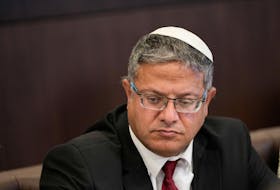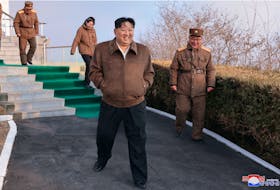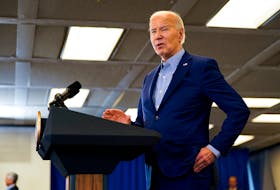Sometimes you just need a bigger car. Or at least a bigger namesake.
“We were the Valiants. We said, not good enough, we need to have a bigger car,” says Rod Norrie, now 76 and chuckling as he reflected on those long-ago days of his teen years.
“It worked.”
They started out as a four-member group of “rookie” musicians who initially named themselves after the newly introduced Plymouth Valiant. They grew into what would become Nova Scotia’s most famous dance band of the day with a name more befitting their stature – the Lincolns.
From the early 1960s right through until they disbanded in 1969 the Lincolns honed their musical talents and entertainment skills as they packed dance halls weekend after weekend throughout Nova Scotia and beyond.
“They weren’t really great, great musicians but the music they played was popular music and their stage presence and their charisma, it just all sort of came together,” said Rod’s wife, Eleanor.
“They were all characters, they were all great on stage, they all had groupies and they played the really popular music of the day, R and B music,” she said. “And Frank MacKay, when he came on, really jelled the whole thing, put it all together.”
But don’t mistake Eleanor for one of those “groupies.” She lightheartedly points out she and Rod were an established couple before the Lincolns were born. But in those early, halcyon days, she did accompany the band to some of the local dances, where she would work the door taking tickets or where needed. After she and Rod were married in 1963, Eleanor and the girlfriends of the other members would gather at her house while the band played at whatever gig they were working on a given night.
Besides Rod, who played drums, the original group of Valiants/Lincolns included the musically schooled Peter Harris on keyboards, Frank Mumford, a natural “showman” who sang and played rhythm and bass guitar and Brian Chisholm, a self-taught lead guitarist who learned his craft while recovering from a broken leg.
Although Rod had reluctantly taken violin lessons – “which I just hated” – for a time, his real interest was drums. He keenly watched street drummers doing their thing and studied the moves of rock band drummers while occasionally pounding away on a set his mother had purchased for him in his mid-teens.
“And they knew I had a set of drums,” Rod said, of the other three. “So they asked me to play and we just went from there. I said I could play them a little bit, not very much. And that was true.”
From their first gig at a local high school, for which they received a whopping $30, the Valiants played at a few dance halls around Colchester County prior to that fateful living room discussion that produced the band name that would soon become known far and wide.
“And people seemed to like us. I think the personalities in the band were good and people were having a good time,” Rod said. “We’d hire a hall, Shortts Lake or Brule Beach … we’d take an ad out in the paper and charge 50 cents or 75 cents and somebody would take tickets and we’d have a dance.”
With the band and their audience having a terrific time, it wasn’t long before it became a whole culture, Eleanor added. “It was before Internet and dances were a big, big part of everybody’s lives.”
While band members changed through the years, the makeup of the group itself remained true to its origins. And what set the Lincolns apart from other groups of the day was their array of instruments – including a Hammond organ – and vocal talent they brought to the stage.
“The Lincolns had horns and an organ and the requisite guitars and percussion,” said longtime fan Danny Joseph. “They also were fronted by a man-child (Frank MacKay) who could sing like his vocal cords were bequeathed by Sam Cooke or Brook Benton or Esther Phillips or Delbert McClinton or that kid from Tupelo, Mississippi. It was music best enjoyed on those sleepy, sultry summer nights at the legion.”
Although the Lincoln’s made their debut and played their early Truro gigs in the bowling-alley-turned-basement hall below the former Ryan’s IGA on Pleasant Street, it was at the Royal Canadian Legion on Brunswick Street where they became a Friday night favourite. Weekend after weekend, for years on end, local teens and out-of-towners would pack the legion auditorium – far beyond what would today meet fire-safety standards.
“The legion was our favourite haunt here in town,” Rod says.
Recalling one dance, held between Christmas and New Year’s, Rod said he was utterly amazed at the door count.
“So we had a special one there one year and I counted the money that night in the back of the legion … there was 1,142 people in that hall. You know, you couldn’t legally put in 250 there today,” he said. “I’m not kidding you. It was just standing room only, that’s all there was.”
MacKay recalls one night when even that number was exceeded.
“It got really ridiculous from about ’67 to ’69, just before we broke up … it got really, really crazy,” he says, the excitement of the day still evident in his voice.
“And the great story I remember, whoever was taking the tickets at the door said, ‘well, we broke the record tonight, guys.’ And I said how many tonight? And they said, ‘1,303.’ That just blew my mind.”
As popular as they were – and remain – however, the Lincolns never went on to great success beyond the dance halls of the day.
“They couldn’t. And the reason they couldn’t is because they were a cover band,” MacKay says. “They were just a glorified cover band but what they had going for them was, they had horns.”
Although the Lincolns disbanded in 1969, they have regrouped for several reunions over the years. And while some of the members have passed on or became spread out across the country, their ability to pack a hall has never waned.
Still today – grey and sporting wrinkles as they may be – their fans of yesteryear are as eager as ever to take that mind-walk back in time.
“I think what that is, that goes back to the legion hall,” MacKay says. “It was almost a right-of-passage. When they left junior high school and entered senior high school … as soon as you went into Grade 10 it almost went hand in hand that you could now go to the Friday night dances. And because of that, the crowds became bigger and bigger and bigger. And those Friday night dances were events. I mean, they really were. At some points they were just astounding. And I think people remember those late teen years with great fondness,” he says. “Everybody had a good time when you went to see the Lincolns.”
* * *
Take a trip back to ’61: The music... the mood... the making of legends
BY FRANK MacKAY
MEMBER OF THE LINCOLNS
In September of 1961 I was an introverted young “Mackerel Snapper” trying desperately to keep up with a new and fast-changing world. Having spent the previous nine years in parochial school being taught by nuns, life as a tenth-grader at Truro Senior High (TSH) was proving to be a downright challenge.
Gone were the days of addressing your teachers as Mother Saint Paula or Sister Isadore. Now it was Mr. Cruikshanks or Levy and Mrs. Fillmore.
During my inaugural week at TSH, I was approached in the hallway one afternoon by the antsiest person I’d ever met. He introduced himself as Brian, said he played bass guitar and that he and a few of his musician friends were putting together a new dance band. Since they still hadn’t found their singer, he wondered if I’d be interested in giving it a shot? The question was no sooner out of his mouth when my knees buckled and I nearly passed out. (Although I had sung at a few junior high functions during my last year at St. Mary’s Catholic School, I definitely didn’t have the experience the guys he was talking about had. Heck, the saxophonist alone was already a rock ‘n’ roll legend in Truro from his days blowing horn with the recording combo The Novatones. Pulling myself together, I asked Brian when he wanted to rehearse? Looking at me like I had a hole in my head he replied: “Rehearse? Nah! Just show up at nine o’clock two nights from now in the cellar of the IGA store at the corner of Prince and Pleasant Streets, and if it works, it works, if it doesn’t it doesn’t.”
As he turned to go, I couldn’t help but notice that his jeans were falling halfway off his rear.
(Sorry you modern-day Justin Bieber fans but your hero wasn’t the first to make wearing “droopy drawers” a fashion statement. Brian Chisholm was killing that look 40 years before Justin was born).
Heeding Brian’s advice, two nights later I was exactly where he asked me to be – in front of the stage at the Pleasant Street Hall, as the basement of the IGA would come to be known. He introduced me to the players: Frank Mumford – guitar; Layne Francis – sax; Roddie Norrie – drums; and before I could produce the list of songs I’d brought along with me, I heard Roddie begin the count in to Little Richard’s “Good Golly Miss Molly.” Figuring it was all-or-nothing time, I jumped in feet first and screamed my way to the sax solo halfway through the tune. As Layne blasted his way through that mini 12-bar break, I felt a rush like never before and knew immediately that “together” we were tapping into something very special indeed.
Without a rehearsal I’m sure we repeated more than just a couple of tunes that first outing but if the house full of dancers seemed to mind, they had a funny way of showing it, calling for two encores before finally allowing the boys to pack up their gear.
And just like that, the story of The Lincolns and their legendary “Friday night dances” was born, with this early edition of the band paving the way for the enormous legion hall success it would enjoy later in the decade.
Prince at Pleasant in Truro was not only the location of the IGA food store and its underground dance hall, it was also the home of George’s restaurant. Situated on Prince directly across from the supermarket, George’s was the social meeting spot for the town’s high-schoolers, collegians, and young working adults. (Think of George’s and its clientele as you might Arnold’s, from the 1970s television series Happy Days, only without that show’s cutesy laugh track). As a member of a suddenly very popular homegrown rock-and-roll band, I too now frequented George’s.
A typical “hang out session” at George’s would begin around 6:30 p.m. and end shortly before 9. (Or if you’d like, from after the supper dishes were done at home until curfew called). The first half of the get-together would usually find a horde of duck-tailed young males hopping from one overcrowded dining booth to another, vying for the attention of the six or seven females squeezed into each, who in turn would be nursing 10-cent sodas and sharing a communal order of fries.
Since each evening basically repeated the one before it, the routine would at some point lead to the sidewalk in front of the building, where night after night the same eight to 10 guys would perpetually stand guard and talk “cars.” Speaking of cars, more often than not a Lincoln bandmate who owned one would show up and before you could say “Fats Domino,” the entire ensemble would be inside the vehicle with him, lighting body farts or punching each other hard in the upper arm. On one such occasion however, something very different happened.
I had just closed the door to George’s behind me and was about to speak to one of the “perpetuals” outside, when I heard the blare of a car horn. Noticing it was coming from Layne Francis’s 1959 blue Plymouth Fury, parked as always beside the IGA on Pleasant facing Prince, I wandered over and joined him. As I climbed inside he blurted out: “Have you ever been down to Murray Dorrington’s?”
Shaking my head, he cautioned: “Hold onto your seat!”
The next thing I knew, Layne was knocking on the door of a small bungalow in an area of Truro I had never been before. To my great surprise the door was opened by Roddie Norrie who led us inside, where, would you believe it, Frank Mumford and Brian Chisholm were waiting. The whole band was there! As I was about to say hello Brian began “shushing me” and pointing to the other side of the room. When I looked in that direction my jaw dropped… big time.
It seemed we had arrived in the middle of a jam session of sorts, as there were four “gentlemen of colour” sitting opposite, making the most joyful sound this side of New Orleans. One played guitar, another drums, while the remaining two were singers. (I felt like I had entered a nightclub where they were the headliners).
The drummer’s setup was fairly simple (snare, hi-hat, and cymbal), and when he “worked it” he did so with brushes instead of sticks. At one point during our stay, he actually left his seat and spent five minutes circling the cymbal, over and over again, attacking it feverishly with the brushes the entire time. I couldn’t believe what I was seeing. (Lesson learned? Talent and showmanship go real well together.)
The guitarist blew my mind. Apparently, the tune we had walked in on was in fact a medley of songs from the late ’40s/early ’50s, and as I watched him move from number to number, he seamlessly took the drummer with him through all the needed musical changes. He was also all over the neck of the guitar with left-hand finger placements that had me completely mesmerized. When I whispered to Frank Mumford, “What is he doing?” Frank replied: “The man grew up listening to jazz, and those are ‘passing chords’ he’s using.” (Ah-ha! Another lesson learned.)
Although there were only two “official” musicians among the four, they certainly weren’t lacking on the bottom end, as one of the singers had a voice so low I swear the pictures on the wall rattled every time he went deep. His talent to mimic bass lines gave the trio a legitimate fullness and in the coziness of that packed little parlour they were more than the real deal to me. (Later, Brian would laugh and say: “That guy imitates a bass guitar better than I play one.”)
I wouldn’t go that far, but I knew where he was coming from.
The final member of the quartet provided all the lead vocals and what was most impressive about him, aside from his velvet smooth voice, was the uncanny knack he had of maintaining pitch as each new song transitioned into its own key. He closed the medley with a rousing version of “When The Saints Go Marching In,” making all in attendance feel like they were in the middle of Bourbon Street during Mardi Gras.
After playing for an hour or so, the foursome took a much-deserved smoke break, during which the lead singer approached and said hello to the band. (He spoke to Layne and to the best of my recollection, the conversation went something like this:
Murray: Hey Layne, where you been hiding? Ain’t seen you in a while.
Layne: Work’s keepin’ me busier than a one-armed paper hanger, Murr.
Murray: Now that’s busy!
Layne: Murray, I want you to meet Frank, he’s the new singer with The Lincolns.
Murray: Hey Frank, how ya doin’? You boys want a beer?
Layne: You bet. Frank?
Me: Uh, okay...
Murray: I’ll be right back.
Layne: This is one of my favourite places to come. Always great musicians hangin’ out here.
Me: Who are these guys?
Layne: The drummer is Wilfred Connors, the guitar player is Clint Halfkenny and the man with those basement notes is Max Halfkenny, Clint’s brother.
Murray: Here you go boys.
Layne: Murr, you sing My Buddy yet?
Murray:My Buddy? You like that old chestnut don’t ya? You ask for it every time you’re here. You bring your horn, you wanna play?
Layne: No, but I really would like Frank to hear you sing that song.
Murray: Well hey, why not… Clint? Gimme the key for My Buddy.
Once he had done so, Clint wrapped his arms around his guitar and brought it to his chest. Then he, Max, and Wilfred fell silent. As a matter of fact, the entire place went still, so much so that when Murray was about to begin you could hear a pin drop. In the midst of all that quiet I was completely unprepared for what happened next. Sitting on the arm of a sofa, his eyes closed, Mr. Dorrington sang the song a cappella, painting as he went a beautiful but sad picture of loss. The lyric told us he was missing someone, but who that person might actually be remained a mystery. After listening to Murray’s absolutely stunning version of what he called “that old chestnut,” I knew exactly who that person was for me, and yet, at the same time, knew it was probably someone very different for each individual in the room. I had just been taught the third and most important lesson of my visit. A great song, interpreted by a great singer, is never limited in its reach and meaning.
The Lincoln’s and their legendary Friday night dances would continue in Truro until September 1969, as would my vocal “Master Classes” at UMD. (The University of Murray Dorrington).
Thank you Murr. You were more than my mentor, you were my buddy. There’s more to singing than screaming to the sax solo…
A. F. (Frank) MacKay – March 14, 2018
* * *
The Lincolns defined a decade
• They broke up in 1969...
• They’ve reunited for
special engagements on
several occasions since...
• And this September, they’re having one more go at it...
Lincolns drummer Rod Norrie, 76, is the only surviving member of the original four.
* * *
Former Lincolns who will be playing at the Sept. 14 and 15 reunion at the legion include: Rod Norrie; Frank MacKay; Donnie Muir; Layne Francis; John Gray; Barry Ryan; Greg (Fish) Fancy; Jack Lilly and Glen Irving.
The concert is a benefit for the Marigold Cultural Centre. Both performances are sold out.
* * *
Eleanor Norrie (Rod’s wife), who worked and travelled around Nova Scotia for the provincial government in a variety of roles, said that whenever someone heard she was from Truro, they wanted to know if she knew Rod Norrie, because of his association with the Lincolns.
* * *
Rod Norrie recalls Frank MacKay’s introduction to the band.
“We had some ruffians from the navy playing with us one time. Some pretty good singers but they were brutes and they wanted to run us, and they just gave us hell all the time.
“And then one day at Pleasant Street hall, people were always coming up: ‘Can I play the guitar? Can I sing? Can I do this, can I play bass?’
“And this guy came up to the bottom of the stage one night, I remember vividly. And he yelled up: ‘Can I sing a couple of numbers?’ So I just sort of rolled my eyes. And he sang about two bars and I just about fell off my stool. Honest to God, he was so good. That was Frank MacKay.
“We called him the next day. We fired the hellions that were giving us shit all the time and the police wouldn’t even let them in the dance hall the next week. The police didn’t’ like them either. And Frank MacKay’s been playing with us ever since. And we love it. He’s just such a great singer, holy cow.
“Danny Boy is a favourite. He has to sing it every night, they make him.”
* * *
Frank MacKay’s recollection is slightly different:
Brian Chisholm was the original bass player and Frank at 16, had just entered Grade 10 Truro Senior High. He said Chisholm approached him one day at school and asked if he wanted to join the band.
“I said, ‘well, do you want to rehearse?’ And he said, ‘nah, just show up on Friday night and if it works it works, and, if it doesn’t, it doesn’t.”
It obviously worked.








